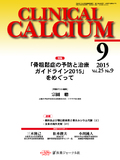Japanese
English
- 有料閲覧
- Abstract 文献概要
- 1ページ目 Look Inside
- 参考文献 Reference
骨粗鬆症は長期ステロイド(GC)治療における最も重要な副作用の1つである。原発性骨粗鬆症に比べて,骨折閾値が高く,投与開始後の急激な骨量減少に対する一時予防が重要であり,各国よりステロイド性骨粗鬆症(GIO)管理ガイドラインが発表されている。10年ぶりに改訂された日本骨代謝学会GIOの管理と治療ガイドラインは,国内のGIOのコホートの解析により独自の骨折危険因子を抽出して,初めてスコア法を薬物療法開始の基準判定に導入した。既存骨折あり,年齢≧65歳,ステロイド投与量≧7.5 mg/日,低骨密度<70 %は単一でも高い危険因子であり,1つでもあれば治療開始の目安となる。さらに,複数の危険因子のスコアの合計で評価することにより,単一因子では評価できない複合的なリスクを評価できる特徴がある。 薬物療法の推奨は,国内で骨粗鬆症治療薬として認証されている薬剤の中から,骨密度減少と骨折の抑制効果があり,かつ一次予防と二次予防の両者において有効性が確認されている薬剤を優先した。第1選択薬としてアレンドロネートとリセドロネートが推奨されている。
Osteoporosis is the most common and important adverse effect of glucocorticoid(GC)therapy. Since GC-induced bone loss is most rapid during the initial 3 - 6 months and primary prevention of bone loss is especially important, guidelines for management of GC-induced osteoporosis have been published overseas and in Japan. The Japanese Society for Bone and Mineral Research(JSBMR)has updated the Guidelines on the Management and Treatment of Glucocorticoid-induced Osteoporosis(GIO)and has incorporated a new scoring method. By analyzing five Japanese GIO cohorts from primary and secondary prevention studies, age, GC dose, lumbar BMD, and prior fragility fractures were identified as factors predicting future fracture and the fracture risk for an individual can be calculated as the sum of the scores for each risk factor. The guidelines were updated on the basis of a score of 3 as the optimal cut-off score for pharmacological intervention. Among the agents approved for the treatment of osteoporosis in Japan, the committee comprehensively reviewed validity for both primary and secondary prevention and assessed the benefit for both BMD and fracture prevention based on the results of clinical studies. Both alendronate and risedronate are recommended as first-line treatment. Ibandronate,teriparatide, and active vitamin D3 derivatives are recommended as alternative option.



